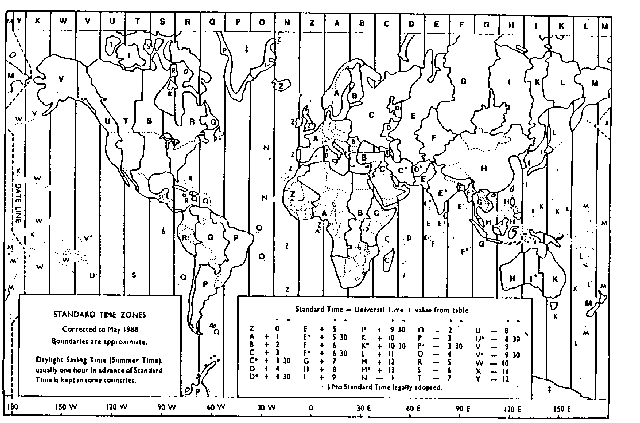Ahhh, but that's not correct. There are some time zones that are a half-hour off of the neighboring one:

Posted on 09/16/2002 7:26:53 AM PDT by aculeus
Electric signals can be transmitted at least four times faster than the speed of light using only basic equipment that would be found in virtually any college science department.
Scientists have sent light signals at faster-than-light speeds over the distances of a few metres for the last two decades - but only with the aid of complicated, expensive equipment. Now physicists at Middle Tennessee State University have broken that speed limit over distances of nearly 120 metres, using off-the-shelf equipment costing just $500.
Jeremy Munday and Bill Robertson made a 120-metre-long cable by alternating six- to eight-metre-long lengths of two different kinds of coaxial cable, each with a different electrical resistance. They hooked this hybrid cable up to two signal generators, one of which broadcast a fast wave, the other a slow one. The waves interfere with each other to produce electric pulses, which can be watched using an oscilloscope.
Any pulse, whether electrical, light or sound, can be imagined as a group of tiny intermingled waves. The energy of this "group pulse" rises and falls over space, with a peak in the middle. The different electrical resistances in the hybrid cable cause the waves in the pulse's rear to reflect off each other, accelerating the pulse's peak forward.
Four billion km/h
By using the oscilloscope to trace the pulse's strength and speed, the researchers confirmed they sent the signal's peak tunnelling through the cable at more than four billion kilometres per hour.
"It really is basement science," Robertson said. The apparatus is so simple that Robertson once assembled the setup from scratch in 40 minutes.
While the peak moves faster than light speed, the total energy of the pulse does not. This means Einstein's relativity is preserved, so do not expect super-fast starships or time machines anytime soon.
Signals also get weaker and more distorted the faster they go, so in theory no useful information can get transmitted at faster-than-light speeds, though Robertson hopes his students and others can now rigorously and cheaply test those ideas.
Physicist Alain Hache at the University of Moncton in Canada adds that it may be possible to use this reflection technique to boost electrical signal speeds in computers and telecommunications grids by more than 50 per cent.
Electrons usually travel at about two-thirds of light speed in wires, slowed down as they bump into atoms. Hache says it may be possible to send usable electrical signals to near light speed.
© Copyright Reed Business Information Ltd.
Not to mentioned the dying planet's psychic scream, which rippled out via the force or something.
"The party of the peoples must act swiftly. Already, evil and greedy students have broken the speed of light with an unregistered basic lab kit.
How can I have another listening tour to tell the peoples how to vote, if I can't see who I'm listening to."
In amateur rocketry, that last consideration is nontrivial even for unmanned flight.
<<<---<)B^)
This looks more akin to sub-space communication. ;-)
But anyone with a DVD of the original Star Wars (I don't) could do a frame by frame analysis of the explosion and calculae the speed of the escaping debris. for example, how long does it take the debris field to double and triple the original planet size?
Long enough for Hans Solo to save Princess Leia
Ahhh, but that's not correct. There are some time zones that are a half-hour off of the neighboring one:

UNless they measured something wrong, or measured by a previous wrong measurement or maybe their equipment was not calibrated correctly or maybe.....nevermind
and now for my secund secound 2nd cup of mornin coffee....
"If you reach total enlightenment while drinking beer, I bet it makes beer come out your nose.
Deep Thoughts- Jack Handy
Actually, this article shows why you should fixate on prestige universities and not let your kid pretend to study physics at middle tennessee state.
This quote "the waves in the pulse's rear to reflect off each other, accelerating the pulse's peak forward. " shows that the experimenters, or the author of the article does not know what they are talking about. The waves do not "accelerate" the peak forward. The wave interference is only making it appear that way.
666,016,199 Miles Per Hour.
It's not just a good idea, it's the Law.
The pulse that "moves" forward, does not move at all. There is a pulse that is the combination of a lot of waves at time=t1 and the pulse you observe moving faster than light is not the same pulse at time=t1 but a brand new pulse that sort of looks like the old pulse but was created by a different interfernce pattern at time=t2. The second pulse is not the same as the first pulse and can not carry information as a result.
About a hundred years ago, the Tennessee State Legislature attempted to pass a law fixing the value of PI at 3. (Using 3.14159265.... was too hard on the children).
From Petr Beckmann's "The History of Pi"
Disclaimer: Opinions posted on Free Republic are those of the individual posters and do not necessarily represent the opinion of Free Republic or its management. All materials posted herein are protected by copyright law and the exemption for fair use of copyrighted works.